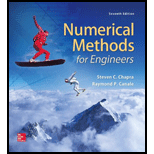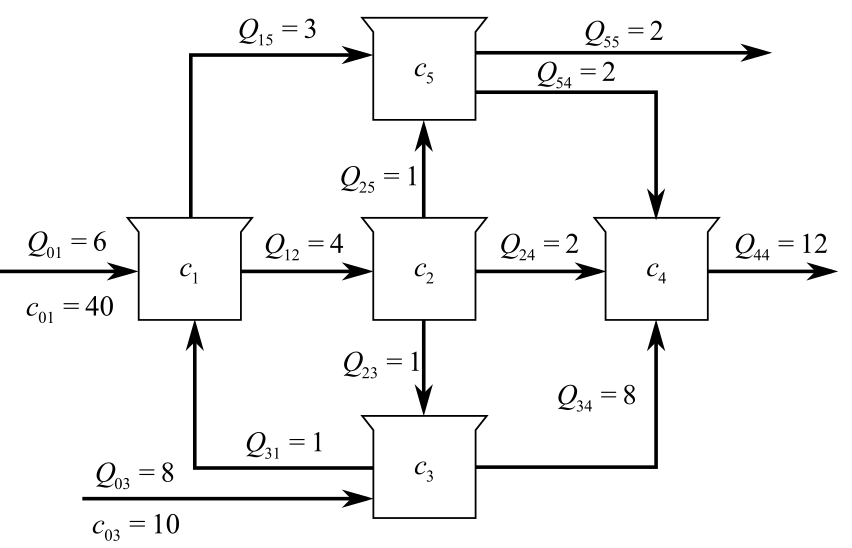
Chemical/Bio Engineering
Perform the same computation as in Sec. 12.1, but change
To calculate: The concentration of the fluid flow rate through the remaining reactors if the value of the following flow changes to
Answer to Problem 1P
Solution: The concentrations
Explanation of Solution
Given Information:
Flow rates are provided as follows:
Also,
Formula used:
Write system of linear equations in matrix form.
And,
The term
Calculation:
Consider the figure provided in the section 12.1.

Here, Q is the flow rate in cubic meter per minute and c is the concentration in milligrams cubic per meter.
For reactor 1, mass flow rate in is expressed as follows,
Mass flow out rate is,
Provided system is in the steady state. Therefore, mass flow rate will be constant.
So,
Substitute the values of the flow rates.
Substitute the known values from the diagram.
For reactor 2, the mass flow rate in is,
The mass flow rate out is,
The system is in steady state flow therefore, the mass flow in and out is same.
Substitute the values of mass flow rates.
Substitute the values of rates of flows from the figure.
For reactor 3, mass flow rate in is,
The mass flow rate out is,
The system is in steady state flow therefore, the mass flow in and out is same.
Substitute the mass flow rate in the above expression.
Substitute the values of the flow rate from the figure.
For reactor 4, mass flow rate in is,
The mass flow out rate is,
The system is in steady state. Therefore, the mass flow rate in and out will be same.
Substitute the mass flow rate values in the above expression.
Substitute the value of the flow rate from the diagram in the above equation.
For reactor 5, the mass flow rate in is,
The mass flow rate out is,
The system is in steady state therefore, the mass flow rate in and out is same.
Substitute the mass flow rate into the expression.
Substitute the value of flow rate into the above expression.
Write all the system of equations to express in a linear system of equations.
Write the above equations in the matrix
Here, coefficient matrix A is,
Column matrix X is,
Column matrix D is,
Use MATLAB to solve the matrix system
The result is obtained as follows:

Hence,
Hence, the concentrations
Want to see more full solutions like this?
Chapter 12 Solutions
Numerical Methods for Engineers
- Complete solution requiredarrow_forwardTopic: Group Theory | Abstract Algebra Question: Let G be a finite group of order 45. Prove that G has a normal subgroup of order 5 or order 9, and describe the number of Sylow subgroups for each. Instructions: • Use Sylow's Theorems (existence, conjugacy, and counting). • List divisors of 45 and compute possibilities for n for p = 3 and p = 5. Show that if n = 1, the subgroup is normal. Conclude about group structure using your analysis.arrow_forwardTopic: Group Theory | Abstract Algebra Question: Let G be a finite group of order 45. Prove that G has a normal subgroup of order 5 or order 9, and describe the number of Sylow subgroups for each. Instructions: • Use Sylow's Theorems (existence, conjugacy, and counting). • List divisors of 45 and compute possibilities for n for p = 3 and p = 5. Show that if n = 1, the subgroup is normal. Conclude about group structure using your analysis.arrow_forward
- Do on pen and paper onlyarrow_forwardProblem 9: The 30-kg pipe is supported at A by a system of five cords. Determine the force in each cord for equilibrium. B 60º A E Harrow_forwardd((x, y), (z, w)) = |xz|+|yw|, show that whether d is a metric on R² or not?. Q3/Let R be a set of real number and d: R² x R² → R such that -> d((x, y), (z, w)) = max{\x - zl, ly - w} show that whether d is a metric on R² or not?. Q4/Let X be a nonempty set and d₁, d₂: XXR are metrics on X let d3,d4, d5: XX → R such that d3(x, y) = 4d2(x, y) d4(x, y) = 3d₁(x, y) +2d2(x, y) d5(x,y) = 2d₁ (x,y))/ 1+ 2d₂(x, y). Show that whether d3, d4 and d5 are metric on X or not?arrow_forward
- Ju at © Ju 370 = x (- пье zxp = c² (2² 4 ) dx² ахе 2 nze dyz t nzp Q/what type of partial differential equation (PDE) are the following-arrow_forwardQ Calculate the Fourier series for f(x) = x on the interval -16≤x≤ Tarrow_forwardFind all positive integers n such that n.2n +1 is a square.arrow_forward
- Algebra & Trigonometry with Analytic GeometryAlgebraISBN:9781133382119Author:SwokowskiPublisher:Cengage
